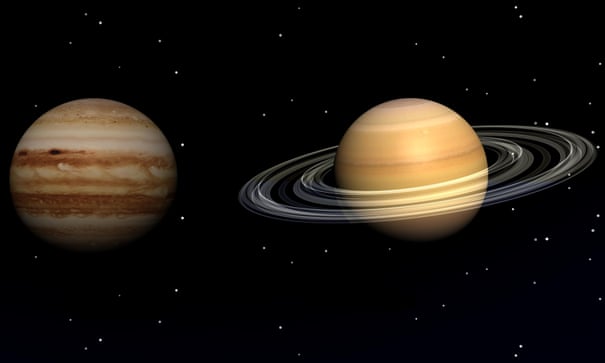Astronomers are gearing up for a heavenly spectacle when Jupiter and Saturn huddle closer together in the evening sky than they have for nearly 400 years, the Guardian reported.
The celestial event will play out on Monday when the solar system’s two largest planets appear side by side in a “great conjunction” above the horizon soon after sunset.
In the distant past, such alignments of the planets were seen as portents of things to come, from great fires and floods to the birth of Christ and the ultimate collapse of civilisation.
The conjunction will peak at 6.37pm UK time, but the event will be visible in Britain from about 4.30pm until 6pm at 15 degrees above the south-west horizon. Noting the danger of cloudy skies, astronomers point out that the pairing can be seen two days either side of the peak.
The orbital paths of the two huge planets ensure great conjunctions every 20 years, but many are impossible to see with the naked eye because they happen during the daytime. Others are less impressive events, as the planets do not come very close together. This year’s will be the closest conjunction since 1623, the year Shakespeare’s collected works were first published.
“It’s really special to have Jupiter and Saturn visible so close together,” said Dr Emily Drabek-Maunder, an astronomer at the Royal Observatory in Greenwich. “It’s something that’s nice to go out and spot.”
The planets will get so close together that they may look like one very bright star. It will be 2080 before the planets align so closely again.
Great conjunctions happen when Jupiter, which laps the sun in a shade under 12 years, and Saturn, which orbits every 29.5 years, come into near alignment with the Earth. This year, the planets will appear in the sky one-fifth of the width of a full moon apart. The event coincides with the winter solstice, when the tilt of the northern hemisphere away from the sun produces the shortest day and the longest night.
Matthew Bate, a professor of theoretical astrophysics at Exeter University, has mounted a telescope on the roof of the physics building and intends to livestream his observations of the planets on Saturday or Sunday over YouTube. This year’s event has particular significance, because there is no record of anyone viewing such a close a great conjunction through a telescope ever before.
“If you have an ordinary, relatively small telescope, you should be able to see Jupiter and Saturn at the same time through the eyepiece,” he said. At medium magnification, Jupiter’s Galilean moons (its four largest satellites), Saturn’s rings and its largest moon Titan should be visible too.
“The cool thing is that Galileo first observed Jupiter and Saturn in 1610, which is 13 years before the last really close conjunction. But there is no record of anyone observing the 1623 conjunction through a telescope,” he said.
There are at least two good reasons for this. First, during the 1623 conjunction, Jupiter and Saturn were close to the sun, so may have set by the time it was dark. “The other thing, of course, is that it’s really dangerous to point a telescope near the sun,” said Bate.
“As far as we know, nobody will have seen Jupiter and Saturn so close together in a telescope eyepiece ever before this year,” he added.
Historical records trace an interest in conjunctions at least as far back as 8th-century Baghdad. But the cosmic couplings captivated scientists for many centuries more. The German astronomer Johannes Kepler observed a great conjunction in 1603, and a supernova the year after. It outshone the brightest stars in the sky. Kepler calculated that another great conjunction must have happened in 7BC. That too, he speculated, may have preceded a supernova, one that is now known as the Christmas star.
Not that many modern scientists would agree. “These conjunctions are big events for astrologers, but scientifically, they’ll have no effect at all on the Earth,” said Bate.
While he hopes to watch from an Exeter rooftop, astronomers at the Royal Observatory in Greenwich are not so lucky with their surroundings. Though nicely positioned for the 1832 transit of Mercury, the observatory’s view to the south-west horizon is largely blocked by trees. “Unfortunately the conjunction is very far west and very low down and the tree line completely obscures our view,” said Drabek-Maunder. “We can’t really get them removed.”
More about: planets
















































